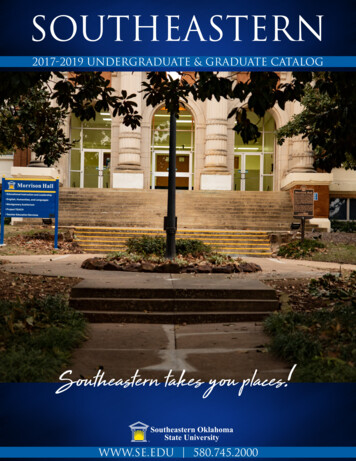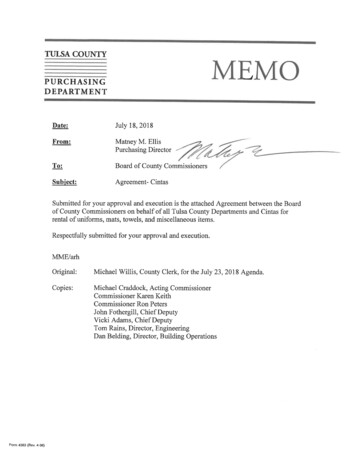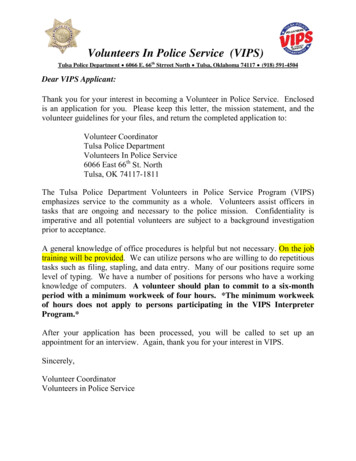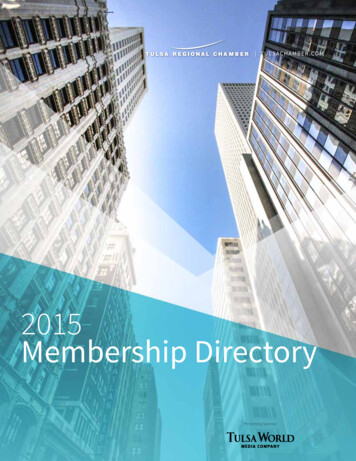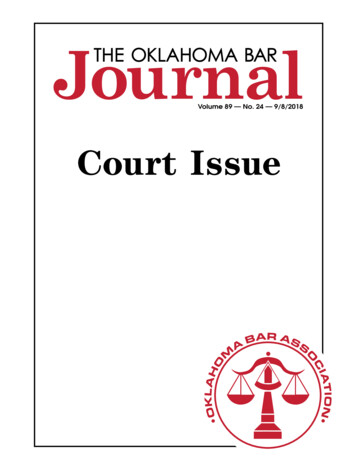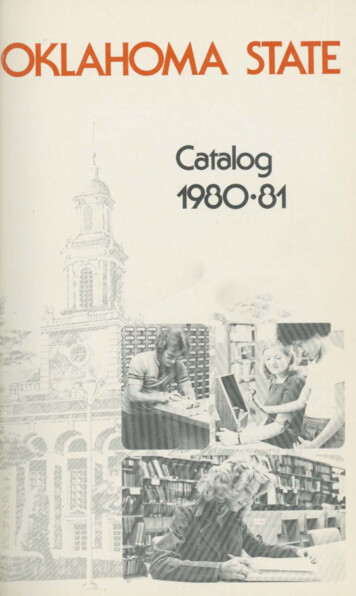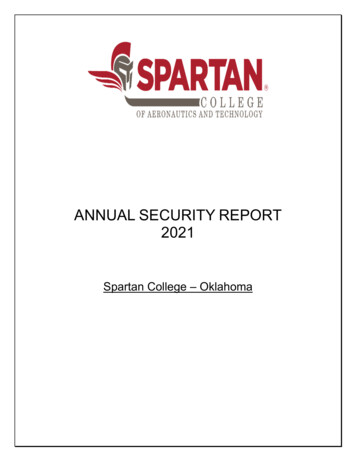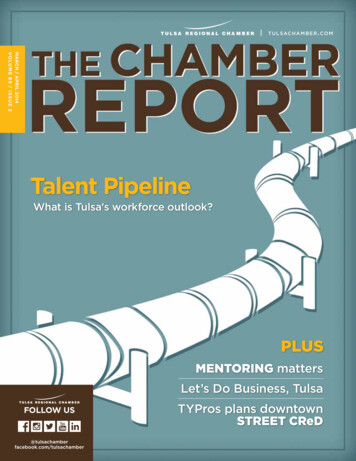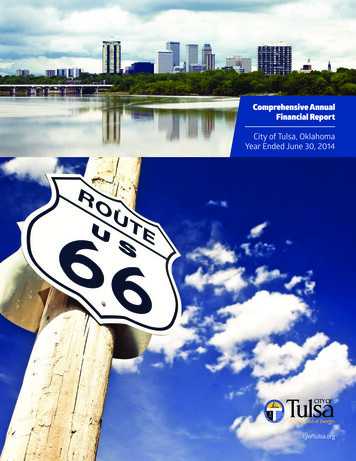
Transcription
Comprehensive AnnualFinancial ReportCity of Tulsa, OklahomaYear Ended June 30, 2014cityoftulsa.org
Comprehensive AnnualFinancial ReportCity of Tulsa, OklahomaYear Ended June 30, 2014MayorDewey F. Bartlett, Jr.Director of FinanceMichael P. Kier, CPFOControllerDavid W. Bryant, CPAcityoftulsa.org
CITY OF TULSACOMPREHENSIVE ANNUAL FINANCIAL REPORTYear ended June 30, 2014TABLE OF CONTENTSPageINTRODUCTORY SECTIONLetter of TransmittalList of Principal OfficialsOrganizational ChartCertificate of AchievementiviiviiiixFINANCIAL SECTIONIndependent Auditor’s ReportManagement’s Discussion and AnalysisA-1MDA-1Basic Financial StatementsGovernment-wide Financial Statements:Statement of Net PositionStatement of ActivitiesFund Financial Statements:Governmental Funds:Balance SheetStatement of Revenues, Expenditures and Changes in Fund BalancesReconciliation of the Statement of Revenues, Expenditures and Changes inFund Balances of Governmental Funds to the Statement of ActivitiesProprietary Funds:Statement of Net PositionStatement of Revenues, Expenses and Changes in Net PositionStatement of Cash Flows12345678Fiduciary Funds:Statement of Fiduciary Net PositionStatement of Changes in Fiduciary Net Position910Discretely Presented Component Units:Statement of Net PositionStatement of Activities1112Notes to Basic Financial StatementsFN-1Required Supplementary InformationDefined Benefit Pension Trust:Schedule of Changes in the Net Pension Liability – Current YearSchedule of Net Pension Liability and Related Ratios – for the current yearSchedule of Employer Contributions – Last ten yearsSchedule of Investment Returns- For the current and prior yearRSI-1RSI-2RSI-3RSI-4Other Post Employment Benefits:Schedule of Funding ProgressSchedule of Actuarial Valuation, Methods and AssumptionsRSI-5RSI-5General Fund Schedule of Revenues, Expenditures and Changes in Fund Balance –Budget and Actual, Budgetary Basis and related notesRSI-6
CITY OF TULSACOMPREHENSIVE ANNUAL FINANCIAL REPORTYear ended June 30, 2014TABLE OF CONTENTSFINANCIAL SECTION (continued)PageSupplemental Combining and Individual Fund Financial Statements and SchedulesGovernmental Funds Subsection:Nonmajor Governmental Funds:Combining Balance SheetCombining Statement of Revenues, Expenditures and Changes in Fund BalancesC-1C-2Budget and Actual Schedules - Budgetary Basis:General Fund:Schedule of Revenues – Budgetary Level of ControlSchedule of Expenditures and Encumbrances – Budgetary Level of ControlE-911 Operating FundEconomic Development FundTulsa Stadium Improvement District FundMedical Services ProgramC-3C-5C-10C-11C-12C-13Internal Service Funds:Combining Statement of Net PositionCombining Statement of Revenues, Expenses and Changes in Net PositionCombining Statement of Cash FlowsC-14C-15C-16Fiduciary Funds:Agency Funds Combining Statement of Changes in Assets and LiabilitiesC-17Component Units:Discretely Presented Nonmajor Component Units:Statement of Net PositionStatement of Revenues, Expenses and Changes in Net PositionC-18C-19Combining Fund Financial Statements of Tulsa Metropolitan Utility Authority:Statement of Net PositionStatement of Revenues, Expenses and Changes in Net PositionC-20C-21Statement of Revenues Expenses and Changes in Net PositionC-22Capital Assets Used in the Operation of Governmental Funds:Comparative Schedules by SourceSchedule of Changes by Function and ActivitySchedule by Function and ActivityC-23C-24C-25STATISTICAL SECTION (Unaudited)Financial Trend Information:Net Position by ComponentChanges in Net PositionGovernmental Activities - Tax Revenues by SourceProgram Revenue by Function / ProgramFund Balances of Governmental FundsChanges in Fund Balances of Governmental FundsS-1S-2S-3S-4S-5S-6
CITY OF TULSACOMPREHENSIVE ANNUAL FINANCIAL REPORTYear ended June 30, 2014TABLE OF CONTENTSSTATISTICAL SECTION (Unaudited - continued)Revenue Capacity Information:General Governmental Tax Revenues by SourcePrincipal Sales Tax RemittersDirect and Overlapping Sales Tax RatesAssessed and Estimated Actual Value of Taxable PropertyProperty Tax Rates - Direct and Overlapping GovernmentsProperty Tax Levies and CollectionsDebt Capacity Information:Ratios of Outstanding Debt by TypeRatios of Net General Bonded Debt to Assessed Values and Net Bonded Debt per CapitaComputation of Direct and Overlapping DebtComputation of Legal Debt MarginPledged Revenue Bond Coverage- One Technology Center – Lease Revenue BondsPledged Revenue Bond Coverage- Arena and Convention – 2008 Capital ImprovementPledged Revenue Bond Coverage- Arena and Convention – 1985 Assembly Center BondsPledged Revenue Bond Coverage- Tulsa Stadium Trust – Lease Revenue BondsPledged Revenue Bond Coverage- Internal Service Financing Fund – 2012 CapitalImprovement S-18S-19S-20S-21Demographic and Economic Information:Demographic and Economic StatisticsS-22Operating Information:Number of City EmployeesOperating Indicators by FunctionTulsa Metropolitan Utility Authority – Water and Sewer RatesAppendix of AbbreviationsS-23S-24S-28S-29
Introductory Section
DEPARTMENT OF FINANCEOFFICE OF THE DIRECTOR OF FINANCEOFFICE OF THE CONTROLLER175 E. Second Street, Suite 885Tulsa, Oklahoma 74103November 14, 2014Honorable Mayor, City Auditor, City Council and Citizens of the City of Tulsa:City of Tulsa, OklahomaWe are pleased to submit to you the Comprehensive Annual Financial Report (CAFR) of the City of Tulsa,Oklahoma (the City) for the year ended June 30, 2014. The CAFR is provided to give detailed informationabout the financial position and activities of the City.City management is responsible for both the accuracy of the presented data and the completeness andfairness of presentations, including all disclosures. We believe the data, as presented, are accurate in allmaterial respects and are presented in a manner which fairly sets forth the financial position and results ofoperations of the City. The CAFR has been prepared in accordance with accounting principles generallyaccepted in the United States (U.S. GAAP) based upon a comprehensive framework of internal control thatit has established for this purpose. The objective of a system of internal controls is to provide reasonable,rather than absolute, assurance that the financial statements are free of any material misstatements.Under Oklahoma state law, municipalities are to publish a complete set of audited financial statements.This report fulfills that requirement for the year ended June 30, 2014. To the best of our knowledge andbelief, the enclosed report is accurate in all material respects and is organized in a manner designed tofairly present the financial position and results of operations of the City as measured by the financialactivity of its various funds. The accompanying disclosures are necessary to enable the reader to gain themaximum understanding of the City’s financial affairs.Independent Auditor’s ReportThe basic financial statements and related notes have been audited by the independent firm of CertifiedPublic Accountants McGladrey LLP. The independent firm concluded that there was a reasonable basis torender an unmodified opinion on the financial statements of each opinion unit that collectively comprisethe City’s basic financial statements, concluding that the basic financial statements are fairly presented inconformity with accounting principals generally accepted in the United States (U.S. GAAP). Theindependent auditor’s report can be found on page A-1 of the Financial Section of this CAFR.Grant awards are being audited under the provisions of the Single Audit Act of 1996, as amended and theSingle Audit reports will be issued separately.Management’s Discussion and Analysis (MD&A)Management’s discussion and analysis immediately follows the independent auditor’s report and providesa narrative introduction, overview, and analysis of the basic financial statements. MD&A complementsthis letter of transmittal and should be read in conjunction with it.i
PROFILE OF THE CITY OF TULSAThe City encompasses an area of approximately 201.5 square miles located in northeastern Oklahoma, atthe edge of the foothills of the Ozarks, along the Arkansas River. The northeastern part of Oklahomais often called “Green Country” due to its wooded terrain in the rolling Ozark foothills. It has an elevationof 700 feet above sea level. The average daily temperature is 61 degrees and the average annual rainfallis 39 inches. With its temperate climate, the City experiences continually changing weather conditionsduring all four seasons of the year.The City was incorporated on January 8, 1898. With the discovery in 1901 of oil in the nearby town of RedFork, Tulsa grew quickly, reaching a population of 7,298 by statehood in 1907. Tulsa’s current populationis 397,737 people, representing a 0.07% increase over 2013. Tulsa is the hub and seat of Tulsa County andis the second largest city in Oklahoma, providing commerce, industrial, transportation and financialservices for a metropolitan area of 969,964 people.Under a Mayor-Council form of government, the Mayor, serving as the chief executive of the City, isresponsible for City operations. The City Council, the legislative branch of the government, consists ofnine members, each representing a distinct geographic district. The City Auditor is responsible for theCity’s Internal Audit Department. The Mayor and City Auditor are elected at large.ServicesThe City provides a full range of basic municipal services, including police and fire protection, streetconstruction, parks, neighborhood revitalization and land use regulation, and other infrastructure,recreational activities, and cultural events. The following services are provided through an array of legallyseparate entities incorporated into this report as component units:ServiceWater and sewer systemsRefuse collection and disposalAirportParkingUrban redevelopmentPublic transportationPerforming ArtsEconomic developmentCommercial leasingArena and conventionSporting events venueEntityTulsa Metropolitan Utility AuthorityTulsa Authority for Recovery of EnergyTulsa Airports Improvement TrustTulsa Parking AuthorityTulsa Development AuthorityMetropolitan Tulsa Transit AuthorityTulsa Performing Arts Center TrustTulsa Industrial AuthorityTulsa Public Facilities AuthorityTulsa Public Facilities AuthorityTulsa Stadium TrustBudgetary Process and ControlsThe Mayor prepares the annual proposed budget and presents it by May 1 to the City Council. TheCouncil reviews, refines, changes, and adopts it according to the policies and priorities it wishes to seeimplemented. Governmental funds with legal annually appropriated budgets are the General Fund andthe Sales Tax Fund (a capital projects fund).The City maintains a system of budgetary controls with the objective of maintaining compliance with theCity Charter and the Oklahoma Municipal Budget Act. The legal level of budgetary control is the level atii
which expenditures cannot exceed appropriations. The level of control is by department and category ofexpenditure within a fund and also by project for capital funds. Expenditures categories are personalservices, materials and supplies, other services, debt service, and capital outlay. Expenditures are cashoutlays plus encumbrances and encumbrances outstanding at year-end are carried forward to be includedin appropriations for the following year.The Local Economy and Factors Affecting Economic ConditionsThe Tulsa Metropolitan Statistical Area (TMSA) comprises 25% of the state’s population and 30.4% of thestate’s economy (TMSA share equals 42.6 billion in 2010 constant dollars).Tulsa has a diverse economy including aerospace manufacturing and aviation, health care, energy,machinery and electrical equipment manufacturing and transportation, and distribution and logistics. TheTulsa Metropolitan Chamber of Commerce reported that several of these sectors have largeconcentrations of employment in the TMSA relative to the rest of the United States. As concentrationsgo: Aerospace parts manufacturing is 2.1 times more, Oil and gas production and machinery manufacturing is 10.8 times more, Pump and compressor manufacturing is 18.6 times more, Fabricated metal product manufacturing is 2.9 times more, Heat-exchanger manufacturing sub-cluster being 49.4 times more than at the U.S. level.Many of these sectors are positioned to grow within the metro area as the cost of doing business andcost of living are 15% and 12% below the national average respectively. Tulsa has one of the shortestaverage commute times in the nation. Tulsa is home to some of the nation’s larger companies includingQuikTrip, ONEOK, and The Williams Companies.thTulsa received several national recognitions in 2014. Site Selection publication ranked Tulsa as 5 in thenation among midsized cities for New and Expanded Corporate Facilities. Global Investment publicationranked Tulsa as 10th in the nation among midsized cities for Foreign Direct Investment Strategy. TheBrookings Institute ranked Tulsa as the 23rd Fastest Growing Metro Area for Exports from 2009 to 2012.The Bureau of Labor Statistics reported the seasonally adjusted unemployment rate for the City at June30, 2014 declined from 5.4% in the previous year to 5.3%. The state and national seasonally adjustedaverage unemployment rates for this same time period were 5.1% and 6.7%, respectively.Bond RatingsIn their report dated December 2013, Moody’s Investors Service assigned and affirmed the City of Tulsaan Aa1 rating. Standard and Poor’s assigned and affirmed an AA rating to the City’s general obligationbonds in their report dated January 2014.Long-term Financial PlanningThe City of Tulsa utilizes these primary planning tools to assist policy makers in addressing near and longterm operating and infrastructure challenges:A Five-Year Financial Forecast and the CapitalImprovements Plan (CIP).Five-Year Financial Forecast -The Annual Five-Year Financial Forecast is prepared to provide policy makerswith the most current information needed to make judgments about the major financial policy issuesfacing the City of Tulsa. It is not a detailed line-item spending plan, service delivery plan, or budget for thenext five years, but an examination of how issues will affect Tulsa's financial condition. It has beendesigned to meet the following objectives:iii
1.2.3.Provide the Mayor and City Council with information about potential financial changes;Provide an updated financial base by which different financing options can be judged; &Provide elected officials information about the long-term impacts of current and anticipatedfinancial policies.As with any multi-year analysis, it is based on assumptions about the future. Of particular importance to astudy of this type is the performance of the national and local economies, since tax revenues anddemands for services are directly related to private sector economic activity.Capital Improvements Plan (CIP) - In 1977, Tulsa's governing body adopted a Capital Improvement Plan(CIP) process which outlined a program to build, in an orderly manner, a large backlog of capital projects.Since then, the City has annually updated the five-year CIP schedule. Building on this tradition, the Cityupdated the CIP development process in 2010. The new policy requires departmental justification ofexpansion projects based on the projects potential return on investment (ROI), its potential leverage andlinkages to other projects, and its contribution to the City’s strategic initiatives. Additionally, allreplacement and rehabilitation projects have been ranked and placed in tiers based on their contributionto public safety, asset preservation, and core service provision. Virtually all of the financing has beenprovided by four sources: General Obligation (GO) bonds, dedicated sales tax, user fees (pay as you goand a source to repay revenue bonds), and state and federal transfer payments. Local voters havecontinually validated this approach as 75% of all GO bond and sales tax proposals have been approvedsince the elected officials adopted the formal capital allocation process.Financial PoliciesThe City follows a comprehensive set of Financial Policies to ensure the City’s financial resources aremanaged prudently. Policies are shaped by state law and approved by the City Council through thebudget adoption process. These financial policies govern the City’s budgeting and financial planning,capital planning, revenue, investment, debt management, and procurement. Descriptions of thesepolicies are available in the City’s annual budget publication which may be obtained from the City’swebsite, www.cityoftulsa.org.Such policies, as shaped by state law and GFOA Best Practices, advise that total resources will besufficient to support current operating expenses. Additionally, the City has established and shallmaintain an operating reserve in the General Fund to provide for revenue shortfalls or to meetunexpected increases in service delivery costs. The reserve is set annually and was set at 6.16% of theGeneral Fund appropriated expenditures for 2014.The City created an Economic Stabilization Reserve in 2012. In an emergency situation, upon meetingcertain triggers, the City may draw on this pool of reserves in the event of declining revenues. The Citymade its first deposit to the reserve in the amount of 2 million in 2013.Major Initiatives (with a Significant Impact on Revenue or Expenditure Trends)The City initiated or completed several projects which provide enhancements for the general public, aswell as the potential to create significant impact on revenue and expenditure trends in the future.Adoption of the Retail Economic Investment Incentive - In 2013, the City Council approved the adoptionof a multi-million dollar incentive program in attracting big-box retailers aimed at making Tulsa morecompetitive with surrounding cities. The program would offer up to 2 million in sales tax rebates forretailers that generate substantial sales tax revenue. Rebates would be limited to public infrastructureinvestments, relative to the amount of tax revenue the retailer remits to the City each year. The incentiveprogram would be capped at 1% of the City’s General Fund operating fund each year. In 2014, the Cityidentified a prospective business for the Incentive Program.iv
Public Safety Tax - In 2014, the Mayor announced a proposal to use 2/10ths of one cent of thecountywide Vision 2025 sales tax which expires in 2016, for a dedicated source of revenue for publicsafety. With this funding, in addition to the general fund allotment, the City would be capable ofemploying 70 additional police officers and 30 additional firefighters for the community. As this is anexisting tax, the effective tax rate of Tulsa would not change upon the implementation of this proposal. Itis the Mayor’s intention to begin discussions of this proposal with the City Council, as well as begin apublic outreach campaign to gather support and feedback for this initiative.Riverside Investments (Gathering Place) - One of Tulsa’s greatest assets is the Arkansas River. Its presencerepresents an incredible opportunity for new development. It should play a vital role in improvingtourism, boosting sales tax revenue, and creating a unique gathering place for Tulsans and people acrossthe region. Recently the George Kaiser Family Foundation has released plans for more river trail andrecreation improvements along the river, as well as the development of a new regional park; TheGathering Place, which is currently slated for completion in early 2017. The City began repairing theexisting low-water dams in late 2013, while ground was broken on the site construction of the GatheringPlace in mid-2014.Consolidation of City/County Parks Citizen Committee - In 2014, the Mayor authorized the formation ofTulsa Leadership Vision Inc., a citizen’s committee charged with examining and making recommendationsregarding the consolidation of the City of Tulsa and Tulsa County park systems. The organization willinvestigate and determine if there may be financial and/or operational efficiencies which could beachieved through the consolidation of the two parks’ systems. Presently, the committee has no chargedauthority, and may only embark on fact-finding efforts.AwardsThe Government Finance Officers Association of the United States and Canada (GFOA) awarded aCertificate of Achievement for Excellence in Financial Reporting to the City of Tulsa for its comprehensivendannual financial report for the year ended June 30, 2013. This was the 32 consecutive year that the Cityof Tulsa has achieved this prestigious award. In order to be awarded a Certificate of Achievement, agovernment must publish an easily readable and efficiently organized comprehensive annual financialreport. This report must satisfy both generally accepted accounting principles and applicable legalrequirements.A Certificate of Achievement is valid for a period of one year only. We believe that our currentcomprehensive annual financial report continues to meet the Certificate of Achievement Program’srequirements and we are submitting it to the GFOA to determine its eligibility for another certificate.The City also received the GFOA’s Distinguished Budget Presentation Award for its annual budgetthdocument dated June 20, 2014. This was the 19 consecutive year for the City of Tulsa. To qualify for theDistinguished Budget Presentation Award, the City’s budget document had to be judged proficient as apolicy document, a financial plan, an operations guide, and a communications device.AcknowledgementsThe preparation of this report could not have been accomplished without the dedicated services of theentire staff of the Finance Department Accounting Division. Other departments and offices of the Cityhave also contributed directly or indirectly to the preparation of this report; the Budget Division, theTreasury Division and other staff throughout the City. We would like to express our appreciation to allwho assisted in this effort.v
CITY OF TULSA,LIST OF PRINCIPAL OFFICIALSMAYORDewey F. Bartlett, Jr.CITY COUNCIL MEMBERSJack R. Henderson . District 1Jeannie Cue . District 2David Patrick. District 3Blake Ewing . District 4Karen Gilbert . District 5Byron Steele . District 6Arianna Moore. District 7Phil Lakin, Jr. . District 8G.T. Bynum . District 9CHIEF OF STAFFJarred BrejchaDIRECTOR OF FINANCEMichael P. Kier, CPFOCITY AUDITORCathy Criswellvii
viiiPerforming Arts CenterBOK & ConventionCentersPoliceFirePublic SafetyCommunications 911Park & RecreationCultural Developmentand RecreationMayor’s OfficeChief of StaffMunicipal CourtsPublic Safety &ProtectionCity AuditorPlanning andEconomicDevelopmentWorking InNeighborhoodsEconomicDevelopmentCommissionSocial and EconomicDevelopmentCity ManagerMayorCitizensORGANIZATION CHARTMTTA AuthorityHuman ResourcesLegalHuman RightsStreets and PublicFacilitiesWater & SewerInternal AuditAdministrative andSupport ServicesEngineering ServicesPublic Works andTransportationDirector ofCommunicationsCity Councilv 3 as of 11/12/2013CommunicationsCustomer Care CenterInformation TechnologyFinanceAsset Management
Government Finance Officers AssociationCertificate ofAchievementfor Excellencein FinancialReportingPresented toText38:City of TulsaOklahomaFor its Comprehensive AnnualFinancial Reportfor the Fiscal Year EndedJune 30, 2013Executive Director/CEOix
Financial Section
Independent Auditor's ReportThe Honorable Mayor and City CouncilCity of Tulsa, OklahomaTulsa, OklahomaReport on the Financial StatementsWe have audited the accompanying financial statements of the governmental activities, the business-typeactivities, the aggregate discretely presented component units, each major fund, and the aggregateremaining fund information of the City of Tulsa, Oklahoma (the City) as of and for the year endedJune 30, 2014, and the related notes to the financial statements, which collectively comprise the City’sbasic financial statements as listed in the table of contents.Management’s Responsibility for the Financial StatementsManagement is responsible for the preparation and fair presentation of these financial statements inaccordance with accounting principles generally accepted in the United States of America; this includesthe design, implementation, and maintenance of internal control relevant to the preparation and fairpresentation of financial statements that are free from material misstatement, whether due to fraud orerror.Auditor’s ResponsibilityOur responsibility is to express opinions on these financial statements based on our audit. We did notaudit the financial statements of the Tulsa Industrial Authority (TIA), which is a discretely presentedcomponent unit of the City. The financial statements of TIA, which comprise 0.7 percent of total assetsand 0.04 percent of total revenues of the aggregate discretely presented component units, were auditedby other auditors whose report has been furnished to us and our opinion, insofar as it relates to theamounts included for TIA, are based solely on the report of the other auditor. We did not audit thefinancial statements of the Tulsa Stadium Trust (TST), which is a blended component unit and majorenterprise fund of the City. The financial statements of TST, which comprise 7 percent of total assets and0.6 percent of total revenues of the business-type activities and represent 100 percent of the assets andrevenues of the TST major enterprise fund, were audited by other auditors whose report has beenfurnished to us and our opinion, insofar as it relates to the amounts included for TST, are based solely onthe report of the other auditor. We did not audit the financial statements of The Operations of the BOKCenter, as managed by SMG, or The Operations of the Cox Business Center, as managed by SMG, anagent operating these facilities (collectively, SMG), which are included within the financial statements ofthe Arena and Convention Center Fund, a major enterprise fund of the City. This activity represents 8percent and 65 percent, respectively, of the total assets and total revenues of the Arena and ConventionCenter major enterprise fund, and 3 percent and 21 percent, respectively, of the total assets and totalrevenues of the business-type activities. Those statements were audited by other auditors whose reportshave been furnished to us and our opinion, insofar as it relates to the amounts included for TheOperations of the BOK Center, as managed by SMG, and The Operations of the Cox Business Center, asmanaged by SMG, are based solely on the reports of the other auditors. We conducted our audit inaccordance with auditing standards generally accepted in the United States of America and the standardsapplicable to financial audits contained in Government Auditing Standards, issued by the ComptrollerGeneral of the United States. Those standards require that we plan and perform the audit to obtainreasonable assurance about whether the financial statements are free from material misstatement.A–1
An audit involves performing procedures to obtain audit evidence about the amounts and disclosures inthe financial statements. The procedures selected depend on the auditor’s judgment, including theassessment of the risks of material misstatement of the financial statements, whether due to fraud orerror. In making those risk assessments, the auditor considers internal control relevant to the entity’spreparation and fair presentation of the financial statements in order to design audit procedures that areappropriate in the circumstances, but not for the purpose of expressing an opinion on the effectiveness ofthe entity’s internal control. Accordingly, we express no such opinion. An audit also includes evaluatingthe appropriateness of accounting policies used and the reasonableness of significant accountingestimates made by management, as well as evaluating the overall presentation of the financialstatements.We believe that the audit evidence we have obtained is sufficient and appropriate to provide a basis forour audit opinions.OpinionsIn our opinion, based on our audit and the reports of other auditors, the financial statements referred toabove present fairly, in all material respects, the respective financial position of the governmentalactivities, the business-type activities, the aggregate discretely presented component units, each majorfund, and the aggregate remaining fund information of the City of Tulsa, Oklahoma, as of June 30, 2014,and the respective changes in financial position and, where applicable, cash flows thereof for the yearthen ended in accordance with accounting principles g
Fork, Tulsa grew quickly, reaching a population of 7,298 by statehood in 1907. Tulsa's current population is the second largest city in Oklahoma, providing commerce, industrial, transportation and financial services for a metropolitan area of 969,964 people. Under a Mayor-Council form of government, the Mayor, serving as the chief executive .

